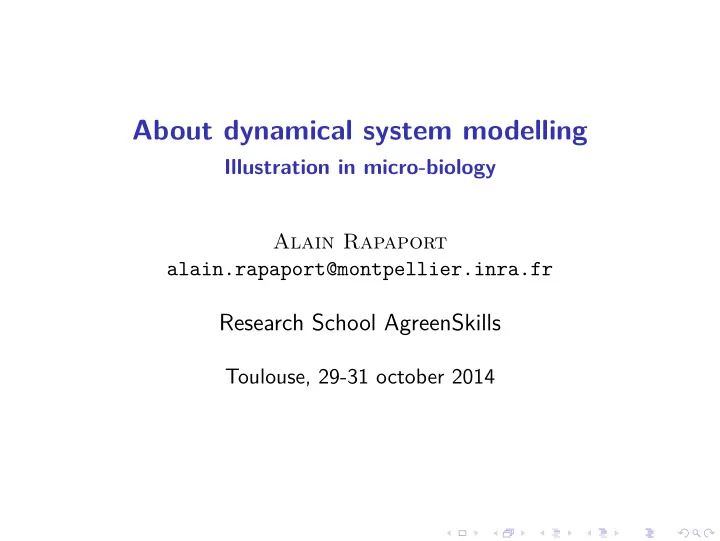

About dynamical system modelling Illustration in micro-biology Alain Rapaport alain.rapaport@montpellier.inra.fr Research School AgreenSkills Toulouse, 29-31 october 2014
Contents ◮ Modeling bacterial growth in batch and continuous cultures ◮ Simple representations of space ◮ Questions related to biodiversity ◮ Modeling and analysis of growth inhibition ◮ Facing models with experimental data
Bacterial growth in batch number of cells per volume time
Bacterial growth in batch number of cells per volume time
The logistic growth (Verhulst, 1838) x max → x ( t ) = � � x max 1 + e − rt x 0 − 1 Equivalent formulation: x ( · ) is solution of the differential equation � � dx x dt = rx 1 − x max
Jacques Monod’s experiments (1930)
Jacques Monod’s experiments (1930) does not fit the logistic curves...
Mathematical modeling Hypothesis H0. There exists y s.t. x + ys = m = cste � � Hypothesis H1a. dx dt = µ sx ⇒ dx dt = µ m 1 − x x y m ���� r Hypothesis H1b. dx dt = µ ( s ) x where µ ( · ) is not necessarily linear: µ S � How to identify with accuracy this specific growth curve?
The chemostat device pump pump feed bootle culture vessel collection vessel Monod 1950 – Novick & Szilard 1950
Dynamical modelling ◮ Mechanics: 2nd motion law: � mass × acceleration = forces ◮ Bio-reaction kinetics: mass balance (for biotic and abiotic): mass variation = � inputs − � outputs + growth − death � �� � for biotic only
Dynamical modelling ◮ chemical kinetics: → P = A α B β ⇒ v = dP dt = k [ A ] α [ B ] β Ex . : α A + β B − ◮ microbial kinetics: → v = dB [ B ][ S ] k Ex . : B + kS − → B + B − dt = ✘✘✘ ❳❳❳ ✘ ❳ growth is not simply a matter of matching bacteria with molecules of substrate...
The mathematical model (in concentrations) dx − Q µ ( s ) x V x dt = + − µ ( s ) Q ds x V ( s in − s ) y dt growth dilution Remark. Q = 0 ⇒ x + ys = constant ˙= d D = Q Simplification and notations. y = 1 dt V s ˙ = − µ ( s ) x + D ( s in − s ) � x ˙ = µ ( s ) x − Dx
Determination of equilibria x ⋆ = 0 µ ( s ⋆ ) = D s = − µ ( s ) x + D ( s in − s ) ˙ ⇒ or s ⋆ = s in x ⋆ = s in − s ⋆ x = µ ( s ) x − Dx ˙ wash-out positive equilibrium µ D S S* S in
Null-clines s = − µ ( s ) x + D ( s in − s ) ˙ x = µ ( s ) x − Dx ˙ x = 0 ˙ s = 0 ˙ x s
Vector field s = − µ ( s ) x + D ( s in − s ) ˙ x = µ ( s ) x − Dx ˙ x = 0 ˙ s = 0 ˙ x s
Phase portrait s = − µ ( s ) x + D ( s in − s ) ˙ x = µ ( s ) x − Dx ˙ x = 0 ˙ s = 0 ˙ x s
Back to experiments For each dilution rate D , one obtains a steady state s ⋆ with µ ( s ⋆ ) = D : µ D 6 D 5 D 4 D 3 D 2 D 1 s s*s* s* s s* s* s* 2 in 1 3 4 5 6
The Monod’s law µ max µ µ ( s ) = µ max s µ K + s : max 2 K S
The chemostat model s = − µ ( s ) x + D ( s in − s ) ˙ x = µ ( s ) x − Dx ˙ Ecology of mountain lakes Industrial bioreactors
For various increasing dilution rates 0 0 0 0 0 0 0 0 0 0 0 0
For various increasing input concentrations 0 0 0 0 0 0 0 0 0 0 0 0
About conversion yield at equilibrium ◮ The mathematical model of the chemostat predicts that the substrate concentration at equilibrium is independant of the input concentration s in (provided that µ ( s in ) > D ). ◮ Micro-biologists report that this property is not verified when the tank is not homogeneous or in natural ecosystems such as soil ecosystems. Question: What is the influence of a spatial repartition on output substrate concentration at steady state?
Recommend
More recommend